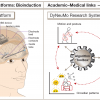Emergence of symmetry selectivity in the visual areas of the human brain: fMRI responses to symmetry presented in both frontoparallel and slanted planes.
Symmetry is effortlessly perceived by humans across changes in viewing geometry. Here, we re-examined the network subserving symmetry processing in the context of up-to-date retinotopic definitions of visual areas. Responses in object selective cortex, as defined by functional localizers, were also examined. We further examined responses to both frontoparallel and slanted symmetry while manipulating attention both toward and away from symmetry. Symmetry-specific responses first emerge in V3 and continue across all downstream areas examined. Of the retinotopic areas, ventral occipital VO1 showed the strongest symmetry response, which was similar in magnitude to the responses observed in object selective cortex. Neural responses were found to increase with both the coherence and folds of symmetry. Compared to passive viewing, drawing attention to symmetry generally increased neural responses and the correspondence of these neural responses with psychophysical performance. Examining symmetry on the slanted plane found responses to again emerge in V3, continue through downstream visual cortex, and be strongest in VO1 and LOB. Both slanted and frontoparallel symmetry evoked similar activity when participants performed a symmetry-related task. However, when a symmetry-unrelated task was performed, fMRI responses to slanted symmetry were reduced relative to their frontoparallel counterparts. These task-related changes provide a neural signature that suggests slant has to be computed ahead of symmetry being appropriately extracted, known as the "normalization" account of symmetry processing. Specifically, our results suggest that normalization occurs naturally when attention is directed toward symmetry and orientation, but becomes interrupted when attention is directed away from these features.
2023. Brain Stimul, 16(5):1412-1424.
2022. Nat Commun, 13(1):7530.
2024. Hum Brain Mapp, 45(2)e26602.
2016.Curr. Biol., 26(7):916-20.
